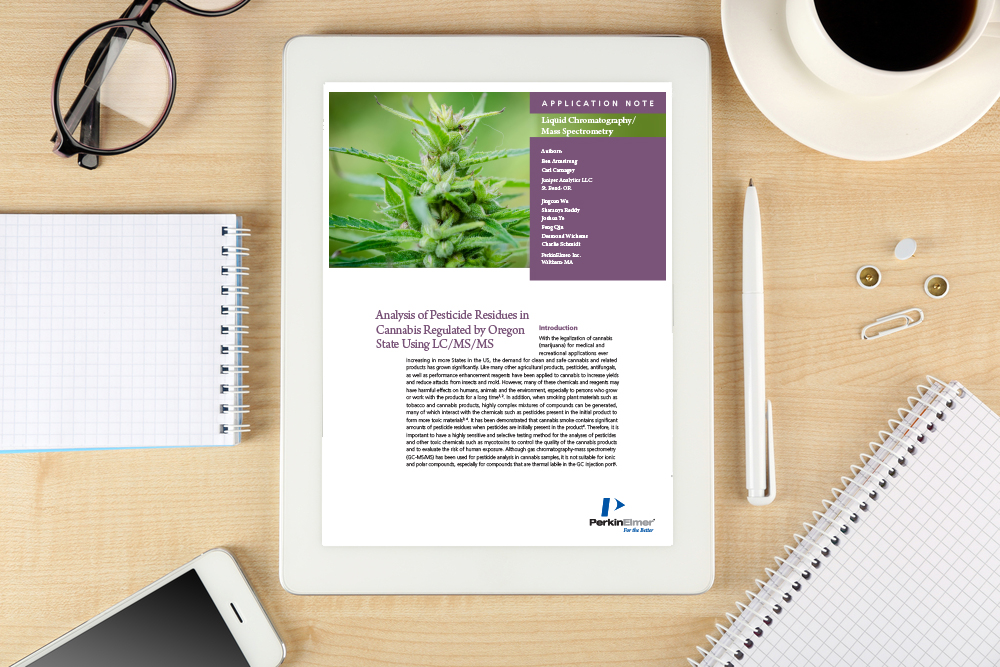Analysis of pesticide residues in cannabis regulated by Oregon State using LC/MS/MS
- Like
- Digg
- Del
- Tumblr
- VKontakte
- Buffer
- Love This
- Odnoklassniki
- Meneame
- Blogger
- Amazon
- Yahoo Mail
- Gmail
- AOL
- Newsvine
- HackerNews
- Evernote
- MySpace
- Mail.ru
- Viadeo
- Line
- Comments
- Yummly
- SMS
- Viber
- Telegram
- Subscribe
- Skype
- Facebook Messenger
- Kakao
- LiveJournal
- Yammer
- Edgar
- Fintel
- Mix
- Instapaper
- Copy Link
Posted: 13 June 2018 | PerkinElmer Inc. | No comments yet
With the legalisation of cannabis (marijuana) for medical and recreational applications ever increasing in more States in the US, the demand for clean and safe cannabis and related products has grown significantly…
Like many other agricultural products, pesticides, antifungals, as well as performance enhancement reagents have been applied to cannabis to increase yields and reduce attacks from insects and mold. However, many of these chemicals and reagents may have harmful effects on humans, animals and the environment, especially to persons who grow or work with the products for a long time. In addition, when smoking plant materials such as tobacco and cannabis products, highly complex mixtures of compounds can be generated, many of which interact with the chemicals such as pesticides present in the initial product to form more toxic materials.
It has been demonstrated that cannabis smoke contains significant amounts of pesticide residues when pesticides are initially present in the product. Therefore, it is important to have a highly sensitive and selective testing method for the analyses of pesticides and other toxic chemicals such as mycotoxins to control the quality of the cannabis products and to evaluate the risk of human exposure. Although gas chromatography-mass spectrometry (GC-MS/MS) has been used for pesticide analysis in cannabis samples, it is not suitable for ionic and polar compounds, especially for compounds that are thermal labile in the GC injection port.
Liquid chromatography-tandem mass spectrometry (LC/MS/MS) has become the method of choice for pesticide analysis due to its high selectivity and sensitivity as well as its suitability for a wide range of compounds in different sample matrices. The state of Oregon has issued regulatory limits for 59 pesticide residues in both cannabis flower and concentrates, while other states have come up with their own lists of pesticide residues relating to medical marijuana and cannabis testing. In this study, all 59 pesticides were spiked into cannabis flower samples and analysed by coupling QuEChERS sample preparation with LC/MS/MS. All the 59 pesticides in Oregon’s regulated list were detected using this methodology, with results well below the current action limits specified. Recoveries of pesticides from spiked cannabis flower extracts are shown to be between 70-120%.
The rest of this content is restricted - login or subscribe free to access


Why subscribe? Join our growing community of thousands of industry professionals and gain access to:
- bi-monthly issues in print and/or digital format
- case studies, whitepapers, webinars and industry-leading content
- breaking news and features
- our extensive online archive of thousands of articles and years of past issues
- ...And it's all free!
Click here to Subscribe today Login here
Related content from this organisation
- Plant-Based Food Revolution: leveraging ICP-MS for quality assurance and nutritional insights
- Application Brief: Solus One Salmonella for Raw Poultry and Meat
- Guide: Solus One Salmonella methodology – Seven easy steps
- Featured Partnership: Challenges in meat pathogen detection – improving your food safety plan
- Poster and Podcast: Rapid recovery and detection of pathogenic Gram-negative organisms
Related topics
CBD hemp & cannabis, Contaminants, Food Safety, Health & Nutrition, Liquid chromatography–mass spectrometry (LC-MS), Pesticides, Regulation & Legislation










